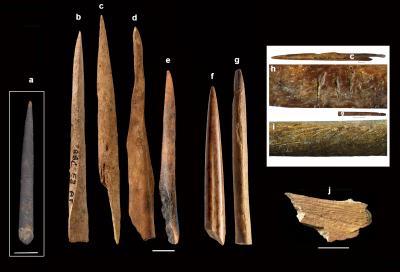While the origins of modern behavior will never be known, new discovery about technological advancement among our ancestors in southern Africa some 70,000 years ago, has taken a step closer to firmly establishing Africa, and especially South Africa, as a primary hub for the early development of our behavior.
A new research paper is the first detailed summary of the time periods a group of international researchers have been studying in South Africa: namely the Still Bay techno-traditions (c. 75 000 – 70 000 years) and the Howiesons Poort techno-tradition (c. 65 000 – 60 000 years).
Wits University archaeologist Prof. Christopher Henshilwood says these periods were significant in the development of Homo sapiens behavior in southern Africa because of many innovations including, the first abstract art (engraved ochre and engraved ostrich eggshell), the first jewelry (shell beads), the first bone tools, the earliest use of the pressure flaking technique that was used in combination with heating to make stone spear points and the first probable use of stone tipped arrows launched by bow.

A Bone point from the Middle Stone Age levels at Peers Cave. The exact context is unknown (see
d'Errico and Henshilwood 2007); Bone tools from the Still Bay levels at Blombos Cave; bone awls;
bone points; engraved lines on tools c and g (see Henshilwood et al. 2001a; d'Errico and
Henshilwood 2007); j engraved bone fragment (see d'Errico et al. 2001)
220 J World Prehist (2012) 25:205-237
123. Credit: Christopher Henshilwood
"All of these innovations, plus many others we are just discovering, clearly show that Homo sapiens in southern Africa at that time were cognitively modern and behaving in many ways like ourselves. It is a good reason to be proud of our earliest, common ancestors who lived and evolved in South Africa and who later spread out into the rest of the world after about 60 000 years," says Henshilwood.
The research also seeks to address some of the nagging questions as to what drove our ancestors to develop these innovative technologieg - they say it is demography and changes in climate, particularly changing sea levels, which were major drivers of innovation and variability in material culture.

These are engraved ochres from the Still Bay M1 phase at Blombos Cave (modified after Henshilwood et al.
2009). This shows; a) Two groups of incisions, one on the center and one close to the edge. In the center two joining lines
form a 'Y' that is crossed by a few perpendicular parallel lines. Three incisions cross these lines; b) Two
lines that cross perpendicularly on the top right margin. Converging lines produced with a single lithic point;
c) this piece retains only a small area of the original engraved pattern. Three straight oblique lines incised on
the top left with two sinuous lines that cross them; d) three distinct sets of lines engraved on a natural surface. Piece was then knapped and a part of the engraving removed; e) a group of sinuous lines engraved on one
face. The opposite face is highly scraped and engraved with a cross-hatched pattern; and f) Cross-hatched pattern incised on one long edge. Credit: Christopher Henshilwood
They note there is increasing evidence for an African origin for behavioral and technological modernity more than 70,000 years ago and that the earliest origin of all Homo sapiens lies in Africa with a special focus in southern Africa.
Henshilwood writes: "In just the past decade our knowledge of Homo sapiens behaviour in the Middle Stone Age, and in particular of the Still Bay and Howiesons Poort, has expanded considerably. With the benefit of hindsight we may ironically conclude that the origins of 'Neanthropic Man', the epitome of behavioural modernity in Europe, lay after all in Africa."
Published in the Journal of World Prehistory




Comments